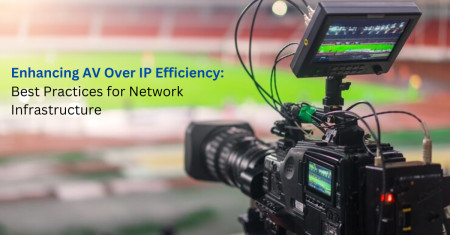Enhancing AV Over IP Efficiency: Best Practices for Network Infrastructure

NEWARK, Del., January 7, 2025 (Newswire.com) - As AV over IP (Audio-Visual over Internet Protocol) technologies gain traction for seamless, high-quality video and audio distribution, optimizing network infrastructure is crucial for system performance and reliability.
As bandwidth & low-latency demands grow, industry leaders are adopting best practices to meet them. Reliable AV over IP deployments depend on robust switches and media converters to handle large-scale data transfers seamlessly.
"As AV over IP transforms modern communication, reliable network infrastructure is essential," said R.W. Tull, President of Versitron. "The right network switches and media converters are critical for seamless AV delivery and optimal performance."
The Importance of Network Infrastructure in AV over IP
AV over IP relies on Ethernet to transmit video, audio, and control signals seamlessly. As systems scale to support 4K and 8K content, robust network infrastructure is essential to avoid latency, jitter, and packet loss, which can disrupt performance and increase downtime.
Success hinges on selecting the right components and designing a network capable of managing high-resolution demands. Key factors like bandwidth, architecture, and redundancy ensure consistent AV performance across various environments such as,
Corporate offices
Educational institutions
Event venues
Broadcast facilities
Best Practices for Optimizing Network Infrastructure
To ensure optimal AV over IP performance, businesses must adhere to best practices when setting up their network infrastructure. Below are key recommendations for optimizing AV over IP systems:
Bandwidth Management: Enabling Next-Gen AV Content
Effective bandwidth management is critical for AV over IP systems, particularly for high-resolution 4K video. Calculate bandwidth needs based on resolution, compression, and frame rate, and prioritize AV traffic to prevent network congestion.
Network Segmentation: Prioritizing AV Traffic with VLANs
Segmenting AV traffic with VLANs prevents bottlenecks, enhances performance, reduces congestion, and simplifies troubleshooting.
Redundancy: Ensuring 24/7 AV System Uptime
Backup power, network pathways, and failover mechanisms ensure continuous AV delivery and minimize downtime.
Proactive Monitoring: Preventing Network Issues
Real-time monitoring tools track usage, diagnose issues, and detect disruptions early, ensuring optimal network performance and future readiness.
The Role of Switches and Media Converters
Network switches & media converters are pivotal in AV over IP systems. Fiber optic network switches ensure reliable transmission of high-quality AV data with minimal latency and packet loss. For instance, uncompressed 4K video may require up to 1Gbps per stream, while compressed formats demand several hundred Mbps. To meet these, switches should support high throughput (e.g., 10Gbps) to avoid bottlenecks and packet loss.
Media converters enhance system flexibility by bridging different network types and enabling long-distance signal transmission without quality loss. For example, they allow seamless integration of copper-based Ethernet with fiber optics, ideal for distances up to 20km.
As AV over IP becomes essential for communication, optimizing infrastructure is key to delivering reliable, high-quality AV experiences. Discover how Versitron's AV over IP solutions can optimize your network. Contact us at sales@versitron.com or call 1-800-537-2296 / 302-894-0699.
Source: Versitron Inc.
